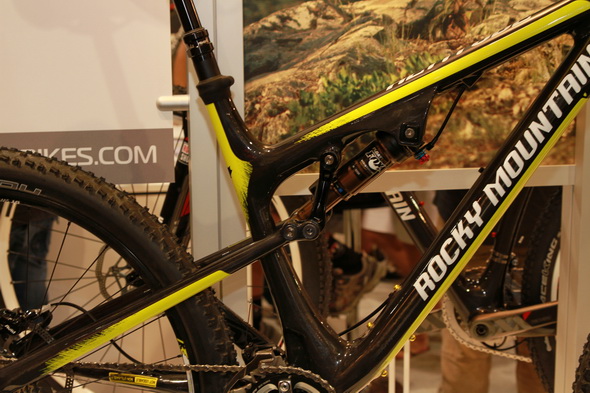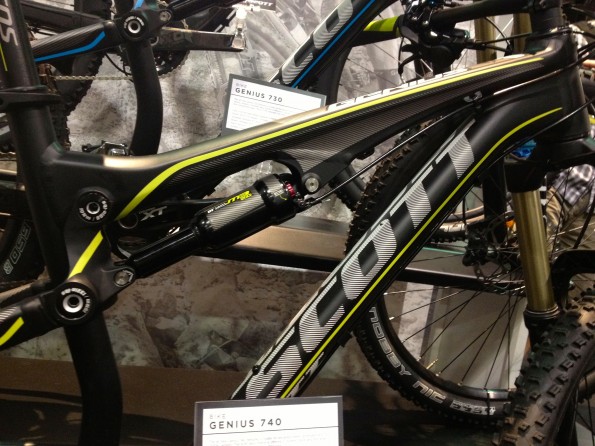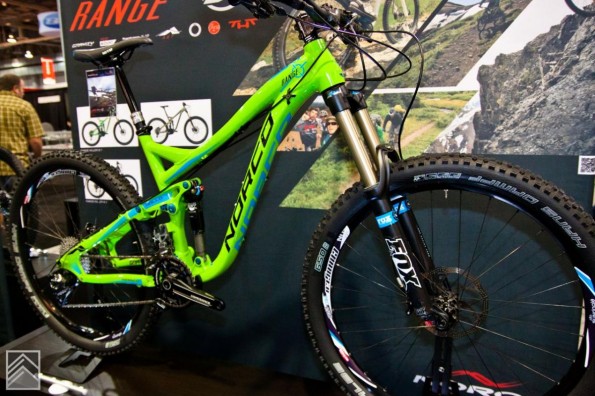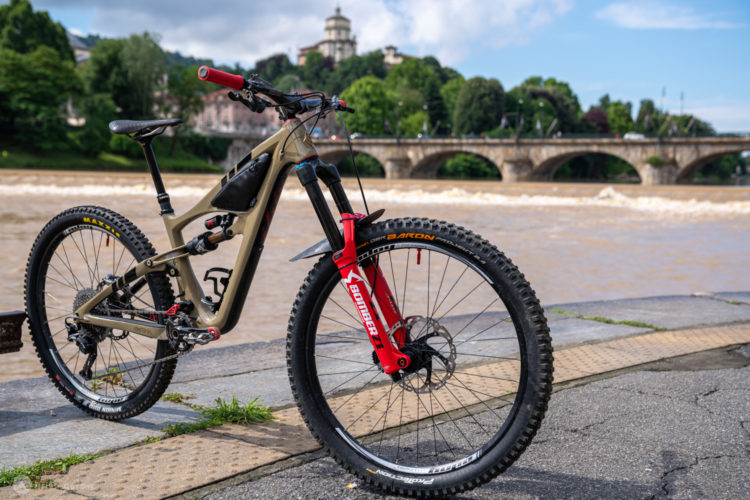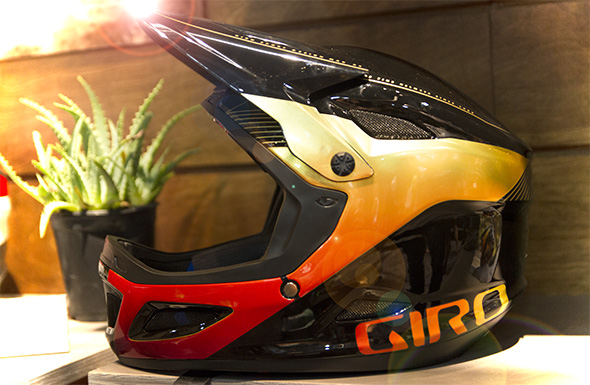Click here to read “The 650b (R)evolution, Part 2: The 650b Godfather, (R)evolution, and 650b Sales.”
While it seems that some companies have jumped into the 650b movement headfirst, other companies are testing the waters with just a couple of models.
Rocky Mountain
Rocky Mountain Altitude
With 150mm of travel, they call the Altitude a 27.5″-wheeled trail killer. Designed for those who want it all in a bike, this is a rig that can descend as well as climb. The Altitude is an all-new design from the frame material to suspension configuration (available in carbon or 7005 series aluminum).
Photo by element22.
Depending on the bike, you’re getting top-shelf components like the CTD Fox system (Fox 34 float and 150 Kashima FIT CTD), with a Fox Float Remote Kashima CTD Custom Trail Valved rear shock for the 790 MSL. Add to that a RockShox Reverb Stealth dropper post, SRAM X0 components all around (crank is the non-series carbon SRAM S2210), DT Swiss wheels, and Raceface Turbine bars and stem and you have one serious ride! The completely blinged-out rig tips the scales at an astonishing 26 pounds. Well, astonishing for a 150mm FS bike anyway.
Ride 9 adjustment system.
Both models have the Ride 9 system, which allows you to tune the bike to your needs. If you’re a heavier rider or prefer to climb more, the adjustment chip has you covered. Basically, adjusting the chip changes the static head and seat tube angles, as well as the bottom bracket height in order to maximize performance.
With three geometry positions (front, middle, rear) and three positions (upper, middle, and lower) you get a total of nine combinations, resulting in the ultimate in adjustability. While at first glance it might not look like much, there are 2-degrees of head tube angle adjustment available here (66.6 degrees to 68.3 degrees). Add an aftermarket Cane Creek Angleset for yet another degree of adjustment, and this just might be the most adjustable, most tuneable mountain bike on the planet!
Scott
For 2013 Scott has completely eliminated the 26″-wheeled Genius from its lineup and completely redesigned the bike around 650b wheels. Available in multiple price points to appeal to riders with pockets of various depths, Scott is by no means completely committing to the wheel size. Still, at present Scott is probably the biggest bike company to go 650b, and if the scientific-looking displays around the booth are any indication, the company thinks this is a trend that will continue to grow.
The Scott Genius.
With a full 150mm of suspension travel, the top of the line Genius 700 SL features a full carbon frame, FOX 34 Talas 650b Factory CTD FIT Kashima Air fork, Scott DT Nude2 rear shock, SRAM XX/X0 drivetrain, SRAM X0 brakes, a RockShox Reverb Stealth dropper post, Syncros TR1.0 Carbon 27.5”/650b wheels, and Schwalbe Nobby Nic Evo tires. I could not find an MSRP quoted on Scott’s website, but found it listed at $9,134.99 online. Prices on the other build kits go down from there.
Norco
Norco had two gorgeous 650b bikes on display: the Range and the Sight.
2013 Norco Range Killer B-1 650b. (Photo by mudhunny.)
The Range Killer B is Norco’s all-mountain bike with 160mm (6.3 in.) of travel and a 66.5 degree headtube angle. The top-of-the-line build kit features excellent Fox CTD suspension (including a 34 TALAS 650B CTD fork), a Sun Charger Pro 650b wheelset, Schwalbe Hans Damph 650b x 2.35″ tires, SRAM X9 drivetrain, SRAM X0 brakes, and a RockShox Reverb dropper post. MSRP for the top-end build kit is $5,850 CAD, but there are two more affordable build kits available.
Range suspension linkage. (Photo by mudhunny.)
Photo by element22.
After checking out so many gorgeous mountain bikes in such a short period of time, I’d be hard pressed to say exactly which bike I liked the most… but the Range is easily one of the best-looking bikes that I spotted.
2013 Norco Sight Killer B-1 650b. (Photo by mudhunny.)
The Sight Killer B is the Range’s little brother, with 140mm (5.5 in.) of suspension and a 67.5-degree headtube angle. The $5,450 CAD top-level build kit features a RockShox Revelation RCT3 fork, Fox Float Factory CTD rear shock, Sun Charger Pro 650b wheelset, Schwalbe Knobby Nic 650b tires, Shimano XT 2×10 drivetrain, Shimano XT brakes, and a RockShox Reverb dropper post. It’s also available in two more affordable build kits.
Norco Sight suspension linkage. (Photo by element22.)
Intense
Intense Tracer 275. (Photo by element22.)
Intense has been making quite a stir with their gorgeous 650b rigs–they’re receiving so many orders that they can’t seem to make them fast enough! While we only got a chance to give the bikes a quick once-over, according to Intense’s website:
The Tracer 275 offers 5.5-6” of adjustable travel, 17” chainstays , a 13.3” bottom bracket, cable routing for RockShox’s Stealth Reverb dropper post, our G1 replaceable dropout system and a modified geometry 67 degree head angle.
Intense Carbine 275. (Photo by element22.)
The Carbine is almost identical to the Tracer, with one key difference: the Tracer is aluminum, and the Carbine is carbon! Mmm… carbon.
Photo by element22.
Overall Trends
Based on what I observed at the show, it seems that, at least for the moment, what I hypothesized a few weeks ago when I wrote my Jamis Dakar SixFiftyB Pro review is holding true: most companies are releasing bikes with 650b wheels in the trail and all-mountain categories. Sure, there are a few companies out there such as KHS and Jamis that are continuing to experiment with 650b wheels across all sorts of platforms, but it seems like everyone else agrees that trail/all-mountain is currently the safest bet.
While we were able to find answers to some of our 650b questions at Interbike 2012, our experience at the show seemed to raise more questions than it answered. Only time will tell whether or not 650b will stick, if any of the Big Three will adopt the tweener wheel size, what the role of the 26″ wheel will have in the future, and what applications 650b will excel in. So stay tuned to Singletracks–we’ll be sure to keep you in the loop!
Your turn: Do you know of any 650b bikes that we missed in our Interbike 2012 coverage? Please let us know about them in the comments section below!












